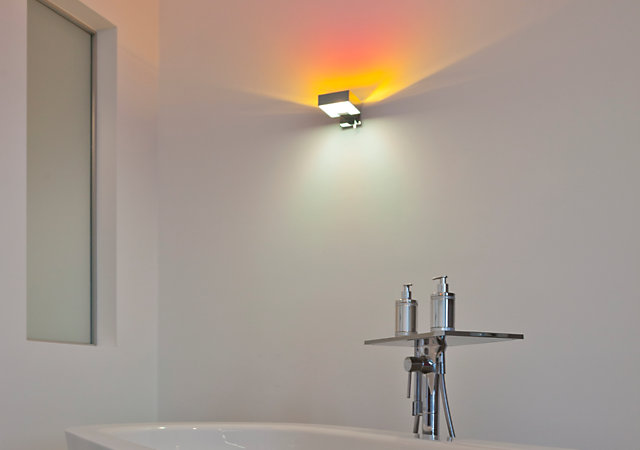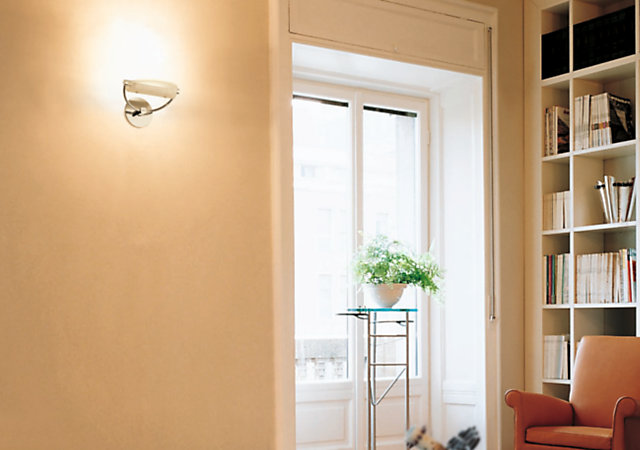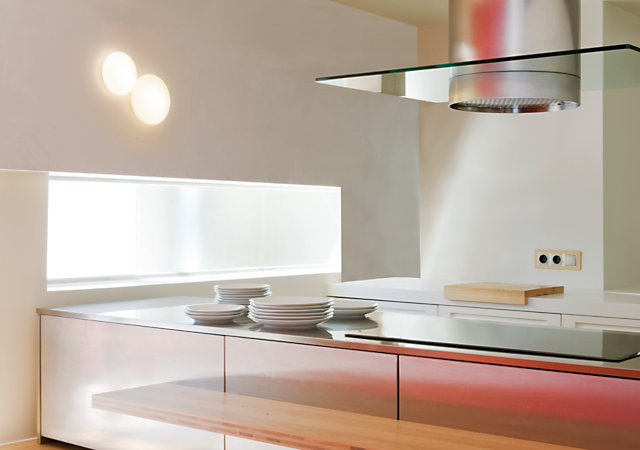As the name suggests,
wall lights, are attached to the wall. The low-profile design versions of this light are particularly well-suited for small rooms such as hallways or bathrooms. Wall luminaires can be used to create ambient lighting or as a form of zone lighting around mirrors. Wall lights typically emit their light upwards and downwards, just upwards, just downwards or in all directions.

Upward and downward light emission
Wall luminaires which emit their light upwards and downwards illuminate the ceiling as well as the wall with their upward-directed light, thereby creating diffuse
ambient lighting. The downward-directed light supplies
zone lightingand illuminates a defined area.
Typical areas of use: this type of wall luminaire is used to ensure ambient lighting, for example, in living rooms, dining rooms and hallways. The light emitted downwards can simultaneously provide zone lighting for sideboards and chests of drawers.
Standard version: this type of luminaire is attached to the wall and has a reflector or a shade with an opening which points upwards and downwards.
The light11 recommendation
- Wall lights must not create bright spots of light on the wall directly above them as these are blinding. Instead, they should illuminate the ceiling and the wall, thereby ensuring pleasant, soft transitions between light and dark.
- Wall lights should be positioned at a height, at which it can be ensured that you cannot look into them from above. This means that the upper light opening should be at a height of approx. 1.70m - 1.80m.
- In staircases, the light source should not be visible from above. Wall luminaires in staircases must therefore emit a sharply focused light upwards and they require good anti-glare shielding. Alternatively, they need to be positioned in a manner which makes it impossible to take a direct look at the light source.
- When illuminating sideboards or chests of drawers, we recommend to symmetrically arrange two luminaires. Ideally, these should be positioned centrally at a distance of half a sideboard or chest of drawers from each other.
- A dimmer is recommended for altering the lighting mood, especially in living rooms and dining rooms.

Adjustable lamps with downward light emission
Wall lamps which emit their light downwards provide directed zone lighting that brightly illuminates a defined area.
Typical areas of use: this type of wall light supplies
zone lighting for sofas and armchairs, beds as well as desks to facilitate reading and working.
Standard version: this type of luminaire is attached to the wall, it has an adjustable arm and a reflector or shade with a downwards-pointing opening.
The light11 recommendation
- Wall lamps which emit their light downwards should evenly and brightly illuminate the defined reading or working area, thereby ensuring pleasant, soft transitions between light and dark. The light emitted should therefore never be too focused as harsh contrasts are extremely tiring on the eyes. A particularly well solution for table lights are halogen lamps which impress by a brilliant colour rendering and warm, white light. In this case, however, precisely positioned reflectors are required to prevent glare and create a sufficiently broad and soft dispersion of the light.
- To avoid glare, the illuminant must in no case be directly visible. The lampshade must therefore be positioned in a way that the light source cannot be seen while you are is a sitting position or when you are reading in bed. In no case may the lampshade be transparent enough for bulbs to shine brightly through it and to thereby cause glare.
- The wall light should be as simple as possible to control whilst sitting or lying. It is therefore beneficial if the switch is directly located on the lamp itself and not at the end of a long cable.

Upward light emission
Wall lights which emit their light upwards illuminate the ceiling and the wall, thereby providing diffuse ambient lighting.
Typical areas of use: this type of wall luminaire is used to supply ambient lighting, for example, in the living room, the
dining room and a hallway.
Standard version: this type of luminaire is attached to the wall and has a reflector or a shade with an opening which points upwards and downwards.
The light11 recommendation
- Wall luminaires must not create bright spots of light on the wall directly above them as these are blinding. Instead, they should illuminate the ceiling and the wall, thereby ensuring pleasant, soft transitions between light and dark.
- Wall lights should be positioned at a height, at which it can be ensured that you cannot look into them from above. This means that the upper light opening should be at a height of approx. 1.70m - 1.80m.
- In staircases, the light source should not be visible from above. Wall luminaires in staircases must therefore emit a sharply focused lights upwards and they require good anti-glare shielding. Alternatively, they need to be positioned in a manner which makes it impossible to take a direct look at the light source.
- A dimmer is recommended for altering the lighting mood, especially in living rooms and dining rooms.

Light emission in all directions
Wall luminaires which emit their light in all directions provide diffuse zone lighting that illuminates the area around the light fixture.
ypical areas of use: this type of wall light is used as a
mirror light in bathrooms, guest toilets and hallways, where it ensures an even, shadow-free illumination of faces.
Standard version: this type of luminaire is attached to the wall and equipped with a diffuser.
The light11 recommendation
- Mirror lights should ensure soft and bright light, which should be glare-free and not dazzling in order to make sure that faces are evenly illuminated without hurting the eyes.
- The most favourable way of illuminating faces is to ensure illumination from all sides (from above, below, left and right).
- The best alternative to this is the illumination from the left and right with possibly elongated luminaires.
- In small guest toilets, the luminaire can be positioned above the mirror to save space.
- As a welcome contrast to the soft, scattered, low shadow zone lighting around the mirror, it is recommended to use focused ambient lighting. Usually, ambient lighting is diffuse and zone lighting is direct. When used to illuminate mirrors, however, this should be just the reverse.
